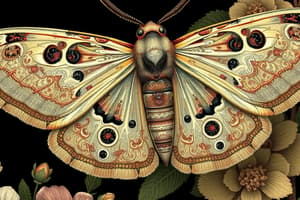Podcast
Questions and Answers
What is a common behavior of peppered moths to avoid predators?
What is a common behavior of peppered moths to avoid predators?
- Moving rapidly during the day
- Flying during the day
- Flying at night and resting during the day (correct)
- Resting during the night and flying during the day
What is the primary function of the pattern on peppered moth wings?
What is the primary function of the pattern on peppered moth wings?
- To scare off predators
- To blend in with the surroundings (correct)
- To regulate body temperature
- To attract mates
What type of organisms are commonly found on the trees where peppered moths live?
What type of organisms are commonly found on the trees where peppered moths live?
- Lichens (correct)
- Vines
- Mushrooms
- Ferns
Why are animals that are sitting still harder to see?
Why are animals that are sitting still harder to see?
Which of the following birds is a predator of the peppered moth?
Which of the following birds is a predator of the peppered moth?
Flashcards are hidden until you start studying
Study Notes
Peppered Moth Predators
- Predators of the peppered moth include flycatchers, nuthatches, and the European robin.
Adaptations for Survival
- Peppered moths fly at night and rest during the day to avoid predators that hunt in daylight.
- Sitting still makes an animal harder to see than a moving one.
Camouflage Mechanisms
- Peppered moths have extra camouflage features to help them hide.
- Trees where peppered moths live have light-colored bark and are covered with small lichens (organisms that are part fungus and part algae or bacteria).
- The pattern on peppered moth wings resembles lichens, providing effective camouflage.
Studying That Suits You
Use AI to generate personalized quizzes and flashcards to suit your learning preferences.




